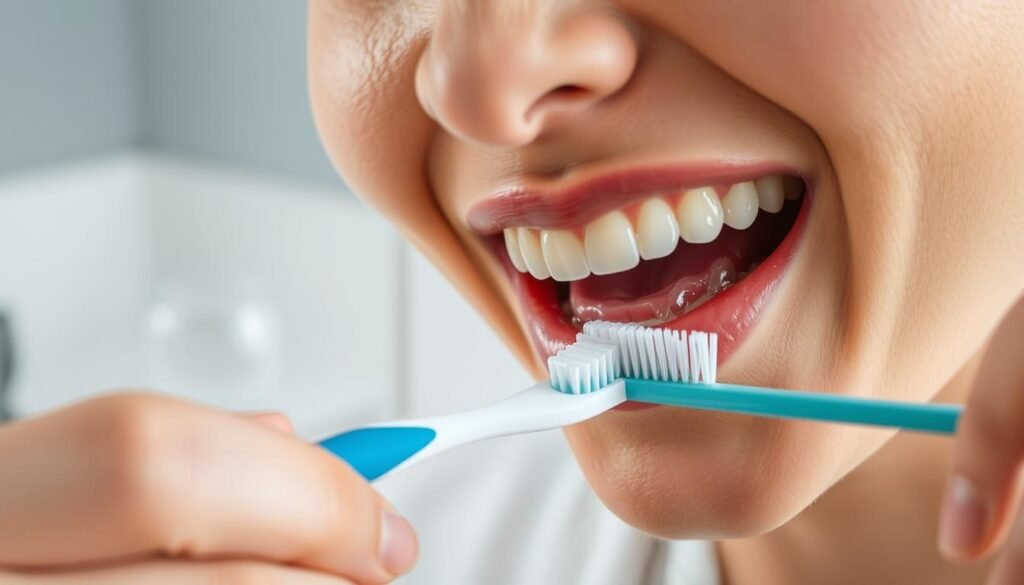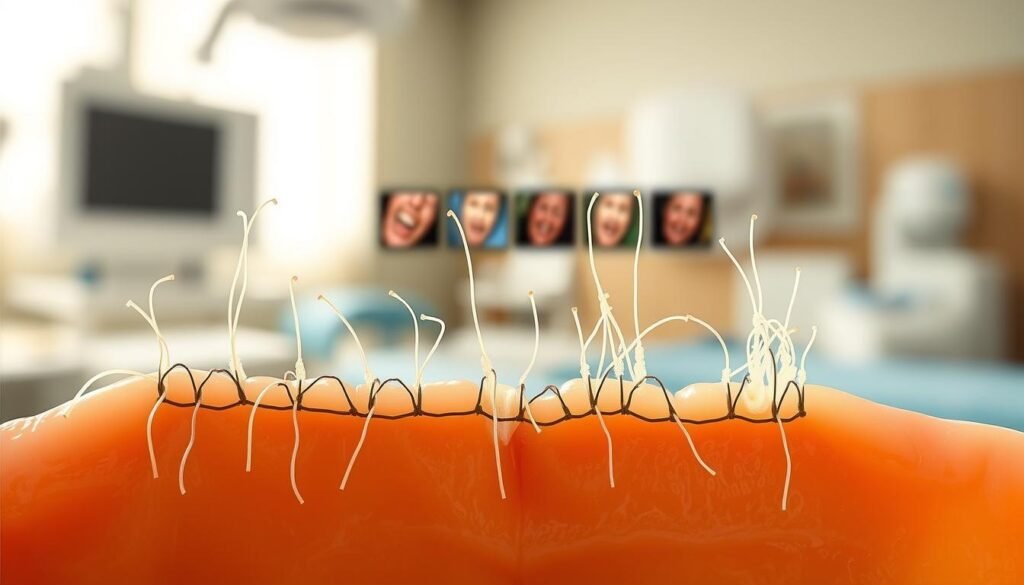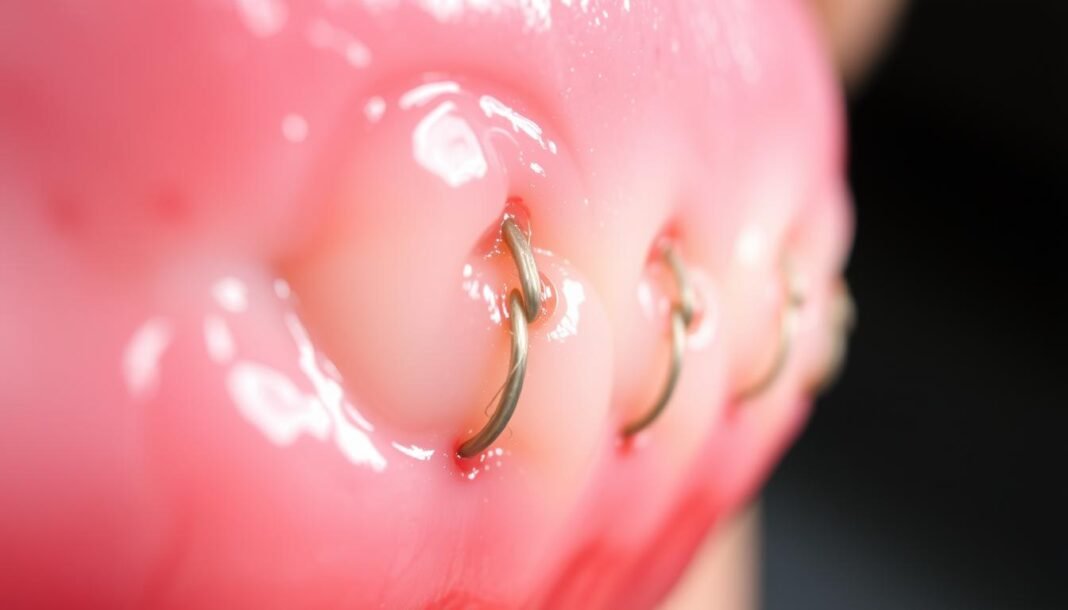After a tooth extraction, dental stitches play a vital role in healing. These sutures close the wound, control bleeding, and protect against infection. Understanding how long tooth extraction stitches stay in place can ease anxiety. Dissolvable stitches like chromic gut may take 10-14 days to break down, while non-dissolvable options like silk need removal in 7-10 days. Proper dental extraction care ensures stitches work effectively, helping gums heal properly.
Your dentist chooses stitches based on your needs. Dissolvable types, such as plain gut, dissolve within weeks, while others require an office visit. Knowing the timeline helps you plan recovery steps and follow post-op instructions carefully.
Key Takeaways
- Most dissolvable stitches dissolve within 5-14 days depending on the material.
- Non-dissolvable stitches must be removed by a dentist 7-10 days post-extraction.
- Stitches reduce bleeding and infection risk during dental extraction care.
- Chromic gut and Vicryl Rapide are common dissolvable options.
- Always follow your dentist’s advice for optimal healing aftercare.
Understanding Tooth Extraction and Stitching
Tooth extraction procedure involves removing a tooth due to damage, infection, or orthodontic needs. Dentists perform this under local anesthesia, carefully removing the tooth and cleaning the socket. This common procedure ensures long-term oral health.
What is Tooth Extraction?
When a tooth cannot be saved, extraction becomes necessary. During the tooth extraction procedure, the dentist numbs the area and gently removes the tooth. Afterward, the focus shifts to healing the site properly.
The Role of Stitches in Healing
Stitches used after extraction serve two key functions: closing the wound and protecting the blood clot. They guide gum tissue alignment, reducing risks like dry socket. Here’s how they work:
- Closing the gum tissue to stabilize the extraction site
- Supporting blood clot formation to prevent complications
- Reducing movement that could delay healing
Stitches act like a biological guide, ensuring the body heals in the right direction.
Two stitch types exist:
| Type | Purpose | Stitches Dissolve Timeline |
|---|---|---|
| Resorbable | Break down naturally | 2–6 weeks |
| Non-resorbable | Require manual removal | Removed at follow-up |
Properly placed stitches shorten recovery and align with the overall stitches dissolve timeline. Always follow post-care instructions to maximize healing benefits.
The Healing Process After Tooth Extraction
Recovery after tooth extraction involves two key phases that require careful attention to dental stitches care and proper habits. Your body starts healing immediately, but full recovery takes weeks. Understanding these stages helps manage expectations and avoid complications.
Initial Healing Phase
Within the first 3–5 days, the focus is on controlling bleeding and reducing swelling. Soft tissues form a blood clot, which must stay intact. Follow your dentist’s advice on rinsing, eating, and avoiding strenuous activity. Dental stitches care here means checking stitches daily for looseness or irritation. Some stitches dissolve, while others need removal in 7–10 days.
Long-Term Recovery
After the first week, the healing process after extraction shifts to tissue regeneration. Bone and gums rebuild over 2–4 weeks. Avoid hard foods and aggressive brushing near the site. Regular check-ins with your dentist ensure stitches are dissolving correctly. Full healing can take months as jawbone remodels, so patience is key.
- Day 1–3: Bite on gauze to clot formation
- Day 4–7: Gentle rinsing with saltwater
- Weeks 2–4: Gradually resume normal eating
Stick to post-op guidelines to prevent infections or dry socket. Regular follow-ups let your dentist monitor progress and adjust care as needed. Proper dental stitches care supports healing and reduces risks.
Factors Affecting Stitch Dissolution
Several factors influence how quickly stitches dissolve after a tooth extraction. These elements shape the stitch dissolution timeline and explain why recovery varies between patients. Understanding these factors helps set realistic expectations for healing.
| Factor | Impact |
|---|---|
| Procedure Complexity | Major surgeries, such as impacted wisdom tooth removal, often use stronger sutures that take longer to dissolve. |
| Suture Material | Materials like polyglactin break down faster than non-absorbable nylon, which may need manual removal. |
| Anatomical Location | Areas with frequent movement (e.g., lower jaw) may delay dissolution due to tension on stitches. |
| Individual Healing Rates | Good post extraction healing speeds up the process, while health conditions like diabetes can slow it down. |
Your dentist selects suture materials based on your case. For example, simple extractions often use fast-dissolving materials to align with typical stitch dissolution timeline ranges. Always follow post-op care instructions to support optimal recovery.
Diet and Oral Hygiene Post-Extraction
A proper diet and careful oral care protect your healing mouth and support the gradual dissolving of dental sutures. After extraction, oral hygiene post extraction practices help prevent infection and reduce irritation near the stitches.
Recommended Foods
- Soft foods like yogurt, mashed potatoes, or oatmeal
- Cool or room-temperature smoothies
- Scrambled eggs or well-cooked pasta
Foods to Avoid
Steer clear of:
- Crunchy snacks like chips or nuts
- Hot soups or beverages
- Carbonated drinks or alcohol
- Straws, which can dislodge blood clots

Gentle brushing is key. Clean teeth carefully with a soft-bristled toothbrush, avoiding the extraction site. Rinsing with warm salt water 2-3 times daily reduces bacteria without disrupting dissolvable dental sutures. Avoid vigorous swishing motions.
Stick to this routine until stitches naturally dissolve, usually within 7-10 days. Any sudden pain or swelling? Contact your dentist promptly.
Managing Discomfort and Pain
After a tooth extraction, mild discomfort is normal during dental extraction recovery. Focus on managing extraction pain with proven strategies to ease symptoms and support healing. Start by taking over-the-counter pain relievers as directed. Ibuprofen reduces inflammation and pain, while acetaminophen provides pain relief without affecting swelling. Always follow dosage instructions carefully.
- Use a cold compress on the cheek for 15-20 minutes at a time to reduce swelling.
- Avoid smoking, strenuous exercise, and hot foods for the first 48 hours.
- Stick to soft foods like yogurt or applesauce to prevent irritation.
Simple home care steps can enhance comfort. Rinse gently with warm salt water 24 hours post-extraction to keep the area clean. For localized relief, apply a diluted clove oil solution or use products like Orajel for temporary numbing. Stay hydrated with room-temperature or cold drinks to avoid disrupting blood clots.
If pain persists beyond 48 hours or worsens, contact your dentist promptly. Proper managing extraction pain ensures smoother recovery and reduces risks like dry socket. Prioritize rest and follow your dentist’s specific instructions to support your body’s natural healing process.
Monitoring for Signs of Infection
After a tooth extraction, mild discomfort and swelling are normal parts of healing. However, recognizing signs of infection post extraction is crucial. Proper oral care after extraction reduces risks, but knowing when to seek help ensures timely treatment.
Common Symptoms
- Persistent Pain: Severe pain lasting beyond 48 hours despite medication.
- Swelling Increase: Swelling worsening after the first day.
- Fever: Temperature above 100.4°F (38°C).
- Pus or Discharge: Thick, yellow/white fluid from the site.
- Bad Taste: Lingering foul odor or metallic taste.
- Jaw Stiffness: Difficulty opening your mouth normally.
When to Seek Help
If you experience any of these symptoms, contact your dentist immediately. Early action prevents complications. Here’s a quick guide:
| Symptom | Action |
|---|---|
| Swelling increasing daily | Call dentist within 24 hours |
| Fever over 100.4°F | Seek care immediately |
| Pus or bleeding | Visit office same day |
Proper oral care after extraction includes gentle rinsing with saltwater and avoiding smoking. But if symptoms escalate, professional care is essential. Always prioritize prompt action to protect your recovery.
When to Resume Normal Activities
After a tooth extraction, patients often wonder about resuming normal activities. Light tasks like walking can usually start within a day, but heavy lifting or intense exercise should wait. Discuss suture removal alternatives with your dentist if stitches cause discomfort—they may recommend dissolvable options to simplify recovery.
- Resuming normal activities safely starts with avoiding strenuous movement for at least 48 hours.
- Avoid smoking, straws, or rigorous workouts for the first week to prevent dry socket or bleeding.
- Stick to soft foods and gentle chewing until your dentist approves harder items.
Most experts advise delaying strenuous activities like running or weightlifting for 7–14 days. Swelling and pain levels are key indicators—rest if you feel discomfort. If your dentist uses non-dissolvable stitches, they’ll guide you on suture removal alternatives or a removal appointment.
Return to work or school when you’re comfortable sitting or standing for extended periods. Physical jobs requiring heavy lifting may need a 2-week delay. Always confirm progress with a follow-up visit to ensure healing is on track.
How Long for Stitches to Dissolve After Tooth Extraction: What to Expect
After a tooth extraction, understanding the expected stitch dissolution timeline helps manage recovery expectations. Most dissolvable stitches disappear within 7–14 days, aligning with the healing process after extraction. Simpler procedures may resolve stitches in 7–10 days, while complex cases can take up to two weeks.

Individual healing speeds vary due to factors like oral hygiene, overall health, and the type of stitches used. For example:
- Smoking or poor nutrition may delay healing
- Biodegradable materials like gut sutures dissolve faster
- Infection or trauma prolongs the process
Your dentist’s instructions are key. Avoid touching stitches or rinsing aggressively, as this disrupts the healing process after extraction. If stitches remain beyond 14 days, contact your dentist for an evaluation. Always follow post-op care steps to ensure your recovery stays on track.
Role of the Dentist in Post-Extraction Care
Your dentist is vital during recovery. They ensure stitches dissolve properly by tracking stitch dissolution factors at follow-up visits. Regular checkups let them assess healing progress and address concerns early.
- Checks for redness or swelling to prevent infections
- Removes stitches manually if they don’t dissolve naturally
- Answers questions about pain management or diet adjustments
Communication matters most. Tell your dentist about unusual symptoms like fever or prolonged bleeding. They’ll guide next steps to avoid complications. The dentist’s role in aftercare also includes explaining home care steps, like gentle mouth rinsing or avoiding smoking.
Trust their expertise. Dentists tailor advice based on your health and how quickly stitches dissolve. Never hesitate to reach out if recovery feels off-track. Their guidance ensures safe healing and proper stitch management.
Preventative Measures to Ensure Optimal Healing
Maintaining proper dental aftercare tips and following preventative measures for healing are vital to avoid complications after a tooth extraction. Simple steps can make a big difference in recovery speed and outcomes.
Post-Extraction Care Tips
- Oral hygiene routine: Gently brush teeth after 24 hours with a soft-bristled toothbrush. Avoid the extraction site to prevent irritation.
- Saltwater rinses: Rinse with a mix of 1 tsp salt in warm water 2–3 times daily. This reduces bacteria and keeps the area clean.
- Food choices: Stick to soft foods like yogurt, mashed potatoes, and soups. Avoid hard, spicy, or hot foods that can disturb the blood clot or cause pain.
Importance of Follow-Up Appointments
Skipping scheduled checkups delays healing. Dentists monitor recovery progress and remove stitches if needed. Attend all appointments to catch issues early and ensure proper healing.
Lifestyle Adjustments
- Avoid smoking or vaping—the chemicals slow healing and increase dry socket risk.
- Limit exercise for 48 hours to prevent bleeding. Intense activity raises blood flow to the head, which can disrupt healing.
- Stay hydrated with a straw-free routine. Sipping water helps, but straws create suction that can dislodge blood clots.
Small changes like these support healing and reduce risks. Prioritizing these steps ensures a faster, safer recovery.
Addressing Concerns and Misconceptions
Many patients have questions about dental stitches and recovery. Here’s how to separate facts from common myths.
Common Myths
| Myth | Fact |
|---|---|
| Stitches always fall out within 2 days | Stitches take 7–10 days to dissolve naturally |
| Swelling means an infection | Some swelling is normal—signs of infection post extraction include fever or pus |
| You can ignore stitch discomfort | Persistent pain needs a dentist’s review |
“Misunderstandings about stitches can delay proper care,” says the American Dental Association. “Education helps prevent complications.”
Expert Advice and Clarifications
Follow these steps to stay safe:
- Check daily for signs of infection post extraction, like swelling that worsens
- Avoid touching stitches—let’s to prevent irritation
- Addressing common myths starts with trusting your dentist’s instructions
Clearing up myths helps you manage recovery confidently. Always reach out to your dentist if unsure. Small steps ensure a smooth healing journey.
Conclusion
Recovery after a tooth extraction depends on several factors, including how well you follow care instructions. Most stitches dissolve within 7 to 14 days, though individual healing speeds vary. Your dentist’s guidance ensures you understand steps to minimize risks like infection.
Optimal recovery after dental extraction relies on sticking to a soft food diet, gentle oral hygiene, and avoiding activities that strain the extraction site. Regular check-ins with your dentist help track progress and address concerns early. These steps reduce complications and support healing.
Communication with your dentist is key. Report any unusual symptoms like severe pain or swelling immediately. Follow-up appointments let them assess healing and confirm stitches are dissolving as expected.
Post extraction conclusion means focusing on your body’s natural healing process. Trust the timeline provided by your dental team and maintain healthy habits. With patience and proper care, you’ll recover smoothly and strengthen your oral health long-term.




